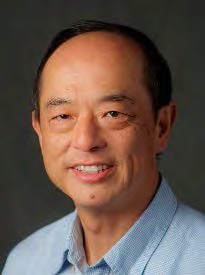
Speaker: James C. M. Hwang
Affiliation: Lehigh University
Ultra-wideband Impedance Spectroscopy of Live Biological Cells
For the first time, the impedance spectrum of live Jurkat T-lymphocytes human cells was characterized in a single sweep spanning six decades of frequency from 9 kHz to 9 GHz. The ultrawide bandwidth bridged the traditional impedance spectroscopy of cell suspensions at radio frequencies with the recently developed microwave dielectric spectroscopy at the single-cell level, which can probe the cell interior noninvasively without being hindered by the cell membrane. Based on the measured scattering parameters and a simple cell model, an equivalent circuit of four nondispersive elements, including membrane resistance, membrane capacitance, cytoplasm resistance, and cytoplasm capacitance, was extracted and found sufficient to explain the so-called β relaxation over the frequencies measured. The extracted membrane capacitance, at 1.0 pF, is consistent with the literature. The extracted cytoplasm resistance, at 0.72 MΩ, is higher than the literature values, but can be explained by having separated out the cytoplasm shunt capacitance. The present cytoplasm capacitance and membrane resistance, at 15 fF and 1.8 MΩ, respectively, are both lower than the literature values. They are believed to be more reliable due to the microwave frequency and the low-conductivity solution used.
In the future, we plan to probe the cell even deeper to separate out the effect of nucleus and other organelles. This will be accomplished mainly by exploiting further the electromagnetic spectrum up the terahertz frequencies, and by designing two-dimensional sensor arrays with submicron spatial resolution. These approaches may be complemented by scanning microwave microscopy and two-dimensional atomic-layer materials and devices.
About the Speaker
Dr. James Hwang is a Professor of Electrical Engineering at Lehigh University. He graduated with a B.S. degree in Physics from National Taiwan University, and M.S. and Ph.D. degrees in Materials Science from Cornell University. After twelve years of industrial experience at IBM, Bell Labs, GE, and GAIN, he joined Lehigh in 1988. He co-founded GAIN and QED; the latter became a public company (IQE). He has been a visiting professor at Shanghai Jiao Tong University, East China Normal University, and University of Science and Technology in China, Nanyang Technological University in Singapore, and Marche Polytechnic University in Italy. Most recently, he was a Program Officer for GHz-THz Electronics at the US Air Force Office of Scientific Research. He is a Life Fellow of the Institute of Electrical and Electronic Engineers. He has published approximately 350 referred technical papers with the impact factor h > 40 according to Google Scholar. He has been granted eight U. S. patents. He has researched on the design, modeling and characterization of microwave, optical and micro-electromechanical (MEM) devices and integrated circuits. His current research interest focuses on electromagnetic sensors for individual biological cells, two-dimensional atomic-layered materials and devices, and scanning microwave microscopy.
Date/Time:
Date(s) - Jan 12, 2018
1:30 pm - 2:30 pm
Location:
2101 Engineering V
420 Westwood Plaza Los Angeles CA 90095
